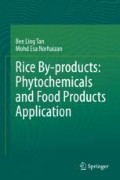Abstract
Rice is one of the universal cereal crops consumed by nearly half of the world population as their daily staple food. Rice milling process produces several by-products including rice bran, rice straw, rice germ, broken rice, rice husk, and brewers’ rice. In particular, rice by-products are rich in bioactive constituents. Many studies have revealed that rice by-products can potentially promote body weight loss, improve insulin sensitivity and glucose control, decrease the risk of cancer, slow down the development of neurodegenerative disorders, improve lipid profiles, alleviate arthritis, and decrease the risk of osteoporosis. Consumer attitude towards nutritious foods is promising and thus the demands of functional foods are increased in the world market. Furthermore, the addition of food additive has become a major concern among consumers. In this regard, rice by-products have been applied as food preservatives and stabilizers, food ingredients for the development of value-added food products, and colorants, as well as utilized as alternative poultry production and fuel industry. Taken together, the utilization of rice by-products in various industries could improve efficiency and reduce waste and thereby decreasing environmental problems. Rice by-products seem a good dietary agent for treating metabolic ailments and providing nutrients.
Access this chapter
Tax calculation will be finalised at checkout
Purchases are for personal use only
References
Aalim H, Belwal T, Wang Y et al (2019) Purification and identification of rice bran (Oryza sativa L.) phenolic compounds with in-vitro antioxidant and antidiabetic activity using macroporous resins. Int J Food Sci Technol 54:715–722
Al-Okbi S, Mohamed DA, Hamed TE et al (2020) Rice bran as source of nutraceuticals for management of cardiovascular diseases, cardio-renal syndrome and hepatic cancer. J Herbmed Pharmacol 9:68–74
Bharathiraja S, Suriya J, Krishnan M et al (2017) Chapter six—production of enzymes from agricultural wastes and their potential industrial applications. Adv Food Nutr Res 80:125–148
Deng G-F, Xu X-R, Zhang Y et al (2013) Phenolic compounds and bioactivities of pigmented rice. Crit Rev Food Sci Nutr 53:296–306
Dokkaew A, Punvittayagul C, Insuan O et al (2019) Protective effects of defatted sticky rice bran extracts on the early stages of hepatocarcinogenesis in rats. Molecules 24:2142
Esa NM, Ling TB, Peng LS (2013) By-products of rice processing: an overview of health benefits and applications. J Rice Res 1:107
Felhi S, Daoud A, Hajlaoui H et al (2017) Solvent extraction effects on phytochemical constituents profiles, antioxidant and antimicrobial activities and functional group analysis of Ecballium elaterium seeds and peels fruits. Food Sci Technol 37:483–492
Gul K, Singh AK, Jabeen R (2016) Nutraceuticals and functional foods: the foods for the future world. Crit Rev Food Sci Nutr 56:2617–2627
Meselhy KM, Shams MM, Sherif NH et al (2019) Phenolic profile and in vivo cytotoxic activity of rice straw extract. Pharm J 11:849–857
Panche AN, Diwan AD, Chandra SR (2016) Flavonoids: an overview. J Nutr Sci 5:e47
Peanparkdee M, Iwamoto S (2019) Bioactive compounds from by-products of rice cultivation and rice processing: extraction and application in the food and pharmaceutical industries. Trends Food Sci Technol 86:109–117
Ryan EP (2011) Bioactive food components and health properties of rice bran. J Am Vet Med Assoc 238:593–600
Tan BL, Norhaizan ME (2017) Scientific evidence of rice by-products for cancer prevention: chemopreventive properties of waste products from rice milling on carcinogenesis in vitro and in vivo. Biomed Res Int 2017:9017902. 18p
Tan BL, Norhaizan ME, Rahman HS et al (2014) Brewers’ rice induces apoptosis in azoxymethane-induced colon carcinogenesis in rats via suppression of cell proliferation and the Wnt signaling pathway. BMC Complement Altern Med 14:304
Tan BL, Norhaizan ME, Huynh K et al (2015) Water extract of brewers’ rice induces apoptosis in human colorectal cancer cells via activation of caspase-3 and caspase-8 and downregulates the Wnt/β-catenin downstream signaling pathway in brewers’ rice-treated rats with azoxymethane-induced colon carcinogenesis. BMC Complement Altern Med 15:205
Tan BL, Norhaizan ME, Liew W-P-P (2018) Nutrients and oxidative stress: Friend or foe? Oxid Med Cell Longev 2018:9719584. 24p
Triratanasirichai K, Singh M, Anal AK (2017) Value-added byproducts from rice processing industries. In: Anal AK (ed) Food processing by-products and their utilization. Wiley and Sons, Hoboken, pp 277–293
Author information
Authors and Affiliations
Rights and permissions
Copyright information
© 2020 Springer Nature Switzerland AG
About this chapter
Cite this chapter
Tan, B.L., Norhaizan, M.E. (2020). Summary and Future Prospects. In: Rice By-products: Phytochemicals and Food Products Application. Springer, Cham. https://doi.org/10.1007/978-3-030-46153-9_7
Download citation
DOI: https://doi.org/10.1007/978-3-030-46153-9_7
Published:
Publisher Name: Springer, Cham
Print ISBN: 978-3-030-46152-2
Online ISBN: 978-3-030-46153-9
eBook Packages: Biomedical and Life SciencesBiomedical and Life Sciences (R0)

